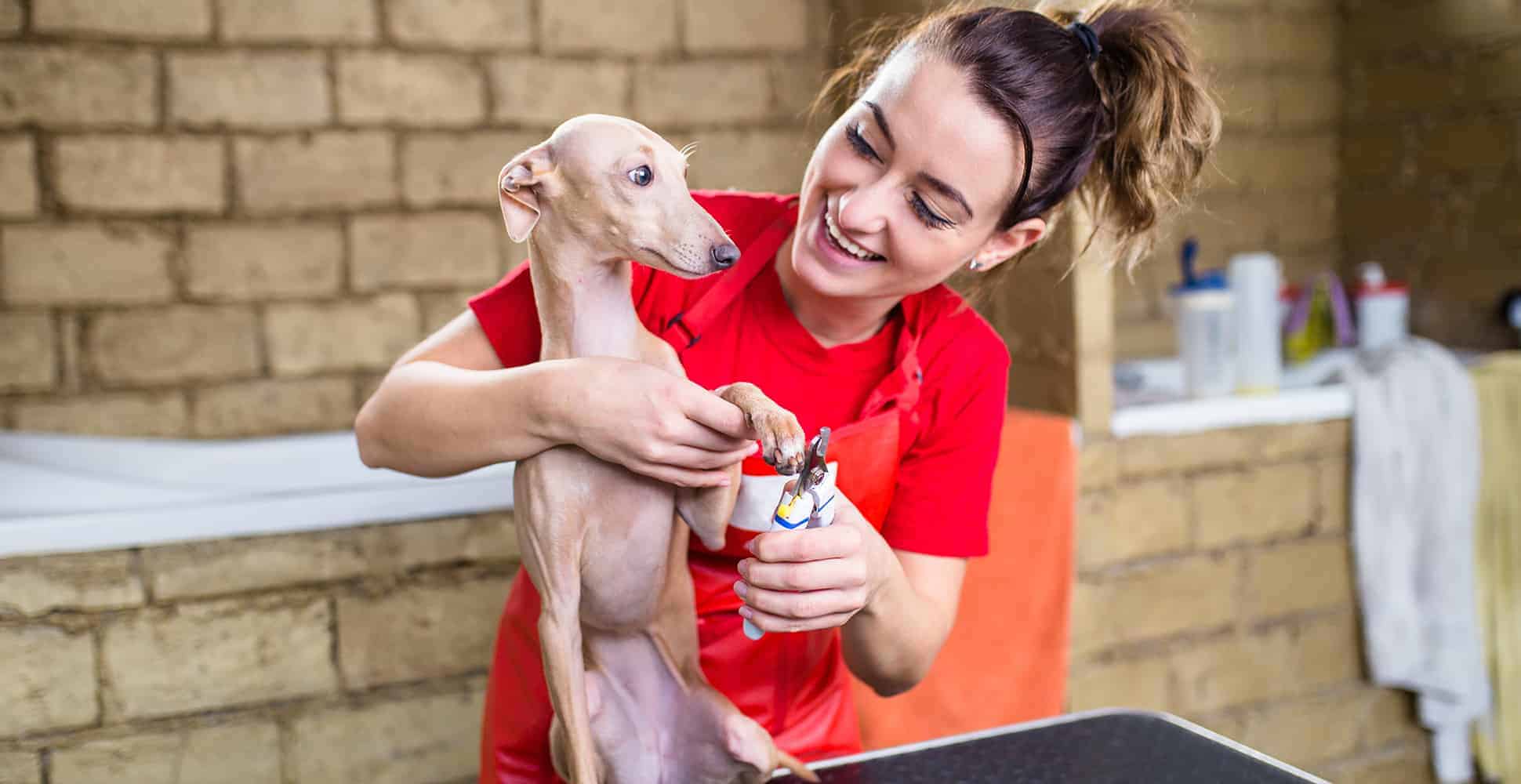The Italian Greyhound, like the Whippet and Greyhound, are one of the easiest breeds to groom. Like most short coated dogs, the Italian Greyhound does not require much time for grooming. Although the Italian Greyhound will shed, the amount will be minimal if the coat is kept in good condition.
The grooming tools and supplies required to keep your Italian Greyhound clean, trim, and neat are easily obtainable.
The grooming table is one of the most important tools in the grooming process. It becomes a safe place to cut your dog’s nails and whiskers, brush his teeth, and clean his ears. Many show enthusiasts can use the table both indoors and outdoors as a convenient place to prepare their dogs for the show ring.
Whether you’re preparing your dog for a show, an obedience trial, or for company, a thorough grooming always starts with brushing. A regular soft brush or a gentle rubdown with your fingers will do the trick in removing loose, dead skin and hair. The Italian Greyhounds seem to really enjoy the brushing and it lends a lustrous shine to their coats as well.
Bathing and Nail Clipping
One of the most important parts of the grooming process is nail clipping. If your dog’s nails are not cut on a regular basis (about every two or three weeks) your Italian Greyhound could suffer serious foot damage. Although every dog is different, your Italian Greyhound may not enjoy the nail clipping process.
The key to having your Italian Greyhound stand still during this important procedure is to start the nail clipping at an early age. Even as young as two to three weeks of age, the Italian Greyhound should be getting used to nail clipping. Also, do not allow any bad behavior such as biting, shaking, or squirming.
Begin by placing the puppy on a sturdy grooming table, giving him positive encouragement to stand. Place the Italian Greyhound under one arm while holding each foot securely and clip. Basically, there are two types of nail trimmers available. The regular handheld nail clippers will do the job and there are several types to choose from.
Many come with an adjustable guard to avoid cutting too much off the nail. The other type is an electric grinder that shortens the nails while buffing them at the same time. The grinder does an excellent job if you can get your Italian Greyhound comfortable with the grinding, buzzing sound.
When cutting your Italian Greyhound’s nails, it is essential to have good lighting. You want to trim as closely to the quick as possible. The pink area inside the nail is the quick and if you cut into it, the dog’s nail will bleed. If you do happen to cut the dog’s nail too closely and the quick begins to bleed, apply some styptic product or cornstarch to stop the bleeding.
If you feel uncomfortable cutting nails, contact a reliable dog groomer or breeder who will be able to cut them for you or at least assist you during the cutting.
Like nail clipping, the secret to having an Italian Greyhound behave during his bath is to start when the dog is a young puppy. Some Italian Greyhounds will love the bathing experience while others will attempt to fly out of the bathtub like a rocket.
The use of  a leash suspended from above should keep the Italian Greyhound safely in place, greatly reducing the risk of the dog jumping out of the tub and injuring himself. The bathing water should be lukewarm and gently poured over the Italian Greyhound.
a leash suspended from above should keep the Italian Greyhound safely in place, greatly reducing the risk of the dog jumping out of the tub and injuring himself. The bathing water should be lukewarm and gently poured over the Italian Greyhound.
Depending on the situation, you may use a mild, medicated, scented, or flea and tick
shampoo. For best results, be sure to let the dog sit for 5-10 minutes before rinsing the leather away.
Unfortunately, all dogs will get fleas at sometime during their lives. An advantage of the Italian Greyhound’s short hair is that it makes it easier to check for fleas or ticks: a fine flea comb will run smoothly through the Italian Greyhound’s hair.
Don’t be alarmed if you do find some fleas or ticks on your Italian Greyhound. You can begin by treating your yard with flea and tick sprays. The next step is to spray the inside of your home or kennel, and around the sleeping quarters of the dog.
The final step would be treating the dog himself. Make sure to use all-natural flea products on the Italian Greyhound. Strong flea sprays and shampoos can be extremely dangerous and possibly fatal to the Italian Greyhound. If you have any questions regarding flea sprays or shampoos, make sure you contact your local veterinarian before starting any flea and tick control program.
Ears, Teeth, and Whiskers
Cleaning the Italian Greyhound’s ears is very simple. You may use a cotton swab, or preferably, a small cotton ball. Dip the cotton ball in some alcohol and squeeze out the excess liquid. Gently fold over the ear of the dog and carefully sweep the inside.
Do not dig deeply into the ear or you may injure the dog. The purpose of ear cleaning is to take away any dirt or excess wax that might be built up on or around the ear canal. Frequent ear cleanings can help reduce ear infections and other ear-related problems.
A physical deficiency with the Italian Greyhound and Toy breeds in general is the teeth. Although the reason is somewhat uncertain, these small dogs require special dental attention. You will quickly realize that the tartar tends to build rapidly around the gums, leaving food particles to gather in between the teeth.
If the tartar is not removed frequently, there will be early teeth loss. Tartar build-up will also lead to unpleasant dog breath, which will make you a little more hesitant when your Italian Greyhound tries to give you that next big, wet kiss.
Brushing your Italian Greyhound’s teeth is a regular grooming necessity and probably one of the most unpleasant experiences for both you and the dog.
Most, if not all, Italian Greyhounds dislike having their teeth brushed. Again, starting the teeth cleaning procedure in the early puppy months is the best solution to having a cooperative Italian Greyhound. There are special dog toothbrushes available, along with dog toothpaste.
We’ve found regular peroxide useful in getting their teeth very clean. The best way to remove tartar buildup is to use a dental pick. Unless you’re an experienced breeder or veterinarian, tartar removal can be a complex procedure. For the safety of both you and your Italian Greyhound, we would recommend that only an experienced individual perform tartar removal.
Although dog bones and dog chew toys help keep teeth somewhat clean, it can never replace a good weekly brushing or scaling. Although it’s not necessary, the trimming of the Italian Greyhound’s whiskers will enhance the smooth outline of the head.
If you intend to actively show your Italian Greyhound, the whiskers should be cut before each show. A small pair of blunt curved grooming scissors is the easiest tool to use. Most dogs are far more cooperative when it comes to whisker trimming than nail clipping or teeth brushing.
These small blunt scissors will not cut the dog severely if he were to suddenly jerk away. Although whisker removal is optional in the show ring, we believe it gives the Italian Greyhound a far neater appearance than having a mouse-like face full of whiskers.
Despite the belief of some dog fanciers that whisker removal is painful, the truth is just the opposite. Whisker removal causes the dog no pain and the dog has no use for them.
Some Italian Greyhound owners choose to trim other areas of the dog, such as the tail, neck, and ears for a cleaner and neater appearance.
In addition, show exhibitors will apply coat spray to create a glossy, smooth, and silky coat, and many exhibitors use chalk to whiten parts of the dog’s coat.

